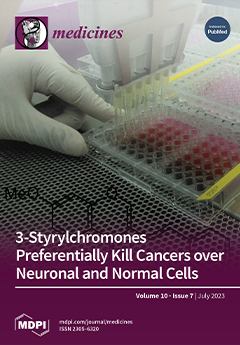Background. Many anti-cancer drugs used in clinical practice cause adverse events such as oral mucositis, neurotoxicity, and extravascular leakage. We have reported that two 3-styrylchromone derivatives, 7-methoxy-3-[(1
E)-2-phenylethenyl]-4
H-1-benzopyran-4-one (Compound
A) and 3-[(1
E)-2-(4-hydroxyphenyl)ethenyl]-7-methoxy-4
H-1-benzopyran-4-one (Compound
B),
[...] Read more.
Background. Many anti-cancer drugs used in clinical practice cause adverse events such as oral mucositis, neurotoxicity, and extravascular leakage. We have reported that two 3-styrylchromone derivatives, 7-methoxy-3-[(1
E)-2-phenylethenyl]-4
H-1-benzopyran-4-one (Compound
A) and 3-[(1
E)-2-(4-hydroxyphenyl)ethenyl]-7-methoxy-4
H-1-benzopyran-4-one (Compound
B), showed the highest tumor-specificity against human oral squamous cell carcinoma (OSCC) cell lines among 291 related compounds. After confirming their superiority by comparing their tumor specificity with newly synthesized 65 derivatives, we investigated the neurotoxicity of these compounds in comparison with four popular anti-cancer drugs.
Methods: Tumor-specificity (TS
M, TS
E, TS
N) was evaluated as the ratio of mean CC
50 for human normal oral mesenchymal (gingival fibroblast, pulp cell), oral epithelial cells (gingival epithelial progenitor), and neuronal cells (PC-12, SH-SY5Y, LY-PPB6, differentiated PC-12) to OSCC cells (Ca9-22, HSC-2), respectively.
Results: Compounds
A and
B showed one order of magnitude higher TS
M than newly synthesized derivatives, confirming its prominent tumor-specificity. Docetaxel showed one order of magnitude higher TS
M, but two orders of magnitude lower TS
E than Compounds
A and
B. Compounds
A and
B showed higher TS
M, TS
E, and TS
N values than doxorubicin, 5-FU, and cisplatin, damaging OSCC cells at concentrations that do not affect the viability of normal epithelial and neuronal cells. QSAR prediction based on the Tox21 database suggested that Compounds
A and
B may inhibit the signaling pathway of estrogen-related receptors.
Full article




